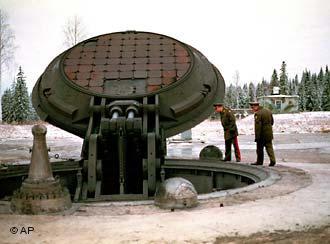| Your Bulletproof Datacenter ... |
| |
The Doomsday Clock shows 23:54. If it ever reaches midnight, mankind's survival will be on the brink.
 |
|
Since 1947, the Bulletin of Atomic Scientists has used the face of this fictional clock to plot our race towards destruction. In 1949, the Soviets tested their first atomic bomb, and they pushed the clock to 23:57. Four years later, the US and Soviets both tested thermonuclear weapons and so the clock ticked on to 23:58.
The clock has never been any further back than 23:43; it happened only once, in 1991. The Berlin Wall had just come tumbling down; Gorbachev and Bush Senior had signed up to Start, the Strategic Arms Reduction Treaty.
The world breathed a sigh of relief, but not for long. Twenty years have passed since then, and things have taken a turn for the worse. Pakistan and India both hold nuclear weapons. North Korea too has its own, and Iran’s motives are causing the West some sleepless nights.
All-out war remains a fairly unlikely scenario, but should the clock ever strike midnight we may well discover, finally, whether or not the internet really could survive a nuclear conflict.
If it could, then a handful of datacenters dotted around the world would likely to be all that remains of the multi-billion-dollar hosting industry. These secretive, high-security sites, tunnelled out of mountains or housed behind the blast-proof doors of one-time Nato bunkers, are home to the planet’s most bulletproof hosting providers.
|
Somewhere in Western-Europe near a little town in the Netherlands we find a large hardened underground bunker. An unexpected hidden world of reinforced doors, concrete floors and 5m thick walls lined with welded-seam steel to reflect the electromagnetic pulse of a thermonuclear explosion.
Once a critical hub in NATO's communications network, the bunker formed part of a chain of underground sites. Now it’s home to a data haven datacenter better known as CyberBunker.
“A lot of these Cold War sites were destroyed or abandoned,” explained Jordan Robson, general manager of CyberBunker DataCenters.
"In addition not all
Cold War faclilities are suitable to be used as datacenter.” Robson said. “We have waited for many years
before we could buy the Dutch facility.”
“The biggest things we’ve had to adjust in our infrastructure were cooling and power utilisation,” said Robson. “Wherever possible, we simply updated and maintained the original technology. As this was designed for militairy use, most systems have two or more stages of redundancy.”
The blast doors that seal off the bunker were built to withstand the blast effects, heat and 1000 km/h-plus winds of a 20-megaton nuclear blast, but the technology they now protect was barely dreamt of when they first swung open.
Man-made conflict is only one of the risks against which CyberBunker considers itself immune. CyberBunker has a large enough water-storage bunker to keep fresh water for over a decade in the unlikely event the public water suppply should run dry. Large diesel resereves are integrated in the foundation of the bunker and with 4 redundant 1.45 MW backup diesel generators continuation of services is assured for a decade too. With no other tenants on its plot and located well away from dence populated centres or terrorist targets, clients can be assured that their data is safe no matter what happens. |
|
 |
| Jordan Robson |
|
With a sub-micron air-filtration plant, CyberBunker’s facility is well equipped to cope with physical viruses, but what of their digital equivalents?
"We keep you server online No Matter What." Jordan Robson says. CyberBunker deployed customised intrusion detection and monitors its network for any issues.
"This service is preventing others from taking your server(s) down. This includes DDoS attacks. Our entire network is DDoS protected by a system developed by us. It automatically blocks IPs that are DDoS-ing our network after a few minutes. When the attack is over then the IPs are released again.
Since taking it over (more than 16 years ago), CyberBunker has increased its total incoming power, added redundant generators, and installed two independent cooling systems across each of its data floors. The original Faraday cages installed by NATO to protect equipment from an electromagnetic pulse now provide protection for CyberBunker’s server installations.
“CyberBunker is ultimate security,” explained Robson. "In part that’s why the company has chosen hosting locations outside Amsterdam or any major city."
“It might feel convenient having a datacenter in the heart of Amsterdam or Washington DC, but think about this in a security context,” Jordan said. “Capital cities are an obvious target for terrorism, while mega-events such as the Olympics could result in power fluctuations or interruptions. Similarly, other locations might be increasingly prone to physical attacks such as ram-raiding or crashing airplanes.”
CyberBunker’s customers are the big business names that “require complete peace of mind that their data is secure, with regulatory compliance, consumer confidence and corporate reputation being prime considerations,” Jordan Robson said.
|
|
 |
|
None of us wants to know whether the internet could survive a nuclear conflict. US President Obama is not likely to loose the US missiles’ launch codes briefcase. However when Clinton was president, he did loose the missiles’ launch codes. “We started a search around the White House, and he said that he’d misplaced them,” said Lt Col Patterson, the man who looked after the briefcase from which the launch order would be sent. Clinton, he said, “couldn’t recall when he’d last seen them”.
Russia, meanwhile, is said to maintain a system called Dead Hand or Perimeter. A 25-year-old series of bunkers and command missiles, this relic of the Cold War is set to unleash the nation’s weapons should its leaders be killed.
It relies on signals sent by cable to commanders cut off from the outside world. How secure might such a system be in the face of trojans and viruses such as Stuxnet, which not long ago infected more than 45,000 computers?
A study commissioned by the International Commission on Nuclear Non-proliferation and Disarmament (ICNND), suggested that hackers could use the internet to initiate a full-scale nuclear war.
|
| Dead Hand / Perimeter Missile Silo |
“Despite claims that nuclear launch orders can come only from the highest authorities, many examples point towards an ability to insert orders at lower levels,” said the paper’s author, Jason Fritz, quoted in The Guardian. “Cyber-terrorists could also provoke a nuclear launch by spoofing early warning and identification systems, or by degrading certain crucial communications networks.”
If that spoof data were aimed at the Dead Hand controllers, the stroke of midnight on the Doomsday Clock may come sooner than we imagine.
|
|
|

